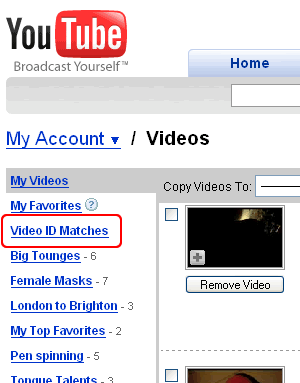 Always keen to stay on top of how content is being used and distributed, a few of us at DL have been playing around with the playlists and ‘channel’ building abilities of YouTube of late.
Always keen to stay on top of how content is being used and distributed, a few of us at DL have been playing around with the playlists and ‘channel’ building abilities of YouTube of late.
While compiling and organising collections of strange video that we found, an interesting options popped out at us.
In the list of playlists on the left hand menu is “Video ID Matches.” Being curious types we had to check it out. Being goody two shoes and not having any copyrighted videos on there, we found that it reported “Our systems have not detected any copyright issues.”
How does video ID matching work?
YouTube have developed a tool that uses fingerprinting — both of the audio and the video — that can identify content that the owners have registered with YouTube.
Once identified, it can be automatically dealt with in a number of ways – Block, Track or Monetize.
Block
Err … well, Block stops the video being show.
Track
With Track, the owners of the content let people watch it, but get reports of the number of times the videos are watched, and possibly other details such as locations of the watchers – the full details of this report aren’t given.
Monetize
Google being Google is never slow to help people (and themselves) make money, not surprisingly via revenue sharing on adverts around the content.
Geo-dependant
The declared owner of the fingerprint can decide by geographical territory which of these three options they can apply.
This structure mirrors the Release Window scheme using in the film business — where they’ve used this to ensure they’re in control of when and where films are released.
If the content that an individual has uploaded is Block-ed in their home territory, but not in others, they’re still able to see/moderate the comments, but can’t actually see the content themselves.
Logo alongside
Under the Video ID scheme, the content owners also has an option to place a graphic logo next to the video content automatically.
If you’re keen to find out more, head on over.
YouTube … please
As a side issue, it’s worth saying that the tools that YouTube provide for handling playlists and altering your YouTube ‘home page’ are shockingly bad. Pretty surprising for a company owned by Google.